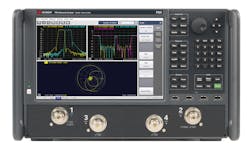Squeeze More Dynamic Range Out of Your Network Analyzer
Achieving the highest possible network-analyzer dynamic range is extremely important in many instances. To attain that goal, it’s important to understand its essence along with the methods that can be employed to increase dynamic range. In the application note, “Understanding and Improving Network Analyzer Dynamic Range,” Keysight Technologies discusses methods that can be utilized to maximize such an analyzer’s dynamic range.
The application note begins by defining dynamic range, with an explanation of the difference between system and receiver dynamic range. System dynamic range can be achieved without amplification, which applies when measuring passive components like attenuators and filters. Receiver dynamic range is the system’s true dynamic range if it’s considered to be a receiver.
After discussing noise floor, the document explains that it’s sometimes desirable to increase the network analyzer’s dynamic range beyond the level obtained with the default settings. The noise floor determines the minimum power level that can be measured by the instrument, thus limiting the dynamic range.
Using averaging techniques or reducing the system IF bandwidth (IF BW) can improve noise floor. Averaging is first discussed in greater detail. When applying the averaging function available in most vector network analyzers (VNAs), signal-to-noise ratio (SNR) is improved by 3 dB for every factor-of-two increase in averages. The downside of averaging is that it also reduces measurement speed, since the measurement time doubles when two traces must be averaged.
Following that discussion, the application note delves into IF BW. The IF BW value affects the digital filtering that’s performed on the data collected in the analyzer’s receivers. Decreasing the IF BW will reduce the noise floor by filtering out noise that’s outside the bandwidth of the digital filter. But like the averaging method, decreasing IF BW also slows the measurement speed. The document also mentions the segmented sweep feature, which is useful for applications that must optimize both speed and dynamic range. Test setup reconfiguration is also mentioned.
Keysight Technologies, 1400 Fountaingrove Parkway, Santa Rosa, CA 95403-1738; (800) 829-4444

